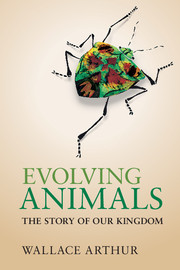Book contents
- Frontmatter
- Dedication
- Contents
- Preface
- Acknowledgements
- 1 What is an animal?
- 2 Before there were animals
- 3 How to make a fossil
- 4 The Cambrian explosion
- 5 How to make a species
- 6 Jellyfish and their kin
- 7 How to make a tree
- 8 The enigmatic urbilaterian
- 9 Animal symmetry and heads
- 10 A plethora of worms
- 11 Trends in animal complexity
- 12 Where the octopus is king
- 13 How to make an animal
- 14 Exoskeletons galore
- 15 Extinction
- 16 Mouth first, mouth second
- 17 Comparing embryos
- 18 Larvae, mouthparts and moulting
- 19 The animal toolkit
- 20 Vertebrate origins and evolution
- 21 From water to land to water
- 22 Variation and inheritance
- 23 Evolutionary novelties
- 24 Human origins and evolution
- 25 Animal plasticity
- 26 The nature of adaptation
- 27 The direction of evolution
- 28 Animal extremophiles
- 29 Extraterrestrial animals?
- 30 The ghost in the machine
- Appendix
- References
- Index
19 - The animal toolkit
Published online by Cambridge University Press: 05 August 2014
- Frontmatter
- Dedication
- Contents
- Preface
- Acknowledgements
- 1 What is an animal?
- 2 Before there were animals
- 3 How to make a fossil
- 4 The Cambrian explosion
- 5 How to make a species
- 6 Jellyfish and their kin
- 7 How to make a tree
- 8 The enigmatic urbilaterian
- 9 Animal symmetry and heads
- 10 A plethora of worms
- 11 Trends in animal complexity
- 12 Where the octopus is king
- 13 How to make an animal
- 14 Exoskeletons galore
- 15 Extinction
- 16 Mouth first, mouth second
- 17 Comparing embryos
- 18 Larvae, mouthparts and moulting
- 19 The animal toolkit
- 20 Vertebrate origins and evolution
- 21 From water to land to water
- 22 Variation and inheritance
- 23 Evolutionary novelties
- 24 Human origins and evolution
- 25 Animal plasticity
- 26 The nature of adaptation
- 27 The direction of evolution
- 28 Animal extremophiles
- 29 Extraterrestrial animals?
- 30 The ghost in the machine
- Appendix
- References
- Index
Summary
We’ve now got a pretty good idea of the overall structure of the animal kingdom. We know that a small number of early lineage splits produced sponges, cnidarians, bilaterians, and a few smaller groups. We know that there was a deep split within the Bilateria, producing the groups that I have informally called the mouth-first and mouth-second ones, these being translations of their official names, protostomes and deuterostomes. We also know that phyla are very asymmetrically divided between these two groups, with the majority belonging to the protostome one. And we have seen that this group underwent a deep split into the moulting animals (Ecdysozoa) and the non-moulting ones that are collected together under the unwieldy name of Lophotrochozoa, because most of them have either a trochophore larva or a ring-of-tentacles (lophophore) feeding structure. Finally, we know where the three biggest animal phyla – the arthropods, molluscs and chordates – fall within this overall pattern of relationships.
Here’s a distinction that we haven’t yet made but that we should make now: the difference between diversity and disparity. I’ve labelled the arthropods, molluscs and chordates as the ‘biggest’ animal phyla because of their number of species. The Arthropoda, with more than a million species, is the biggest phylum by far. Of its four subphyla, the Insecta is easily the largest, containing about 80% of arthropods. So the Insecta has a high diversity – meaning a large number of species. But it’s quite low in disparity.
- Type
- Chapter
- Information
- Evolving AnimalsThe Story of our Kingdom, pp. 187 - 200Publisher: Cambridge University PressPrint publication year: 2014



